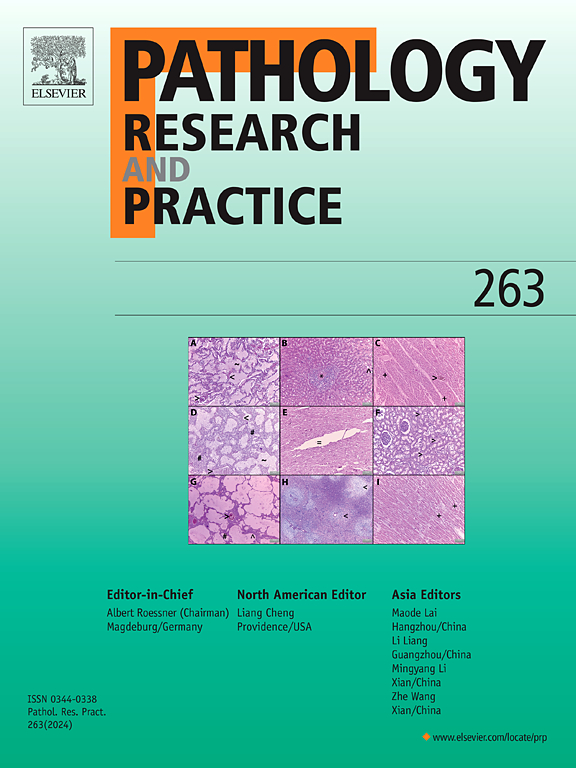睾丸精原细胞瘤组织中CacyBP/SIP表达及其与ERK1/2和p38激酶的关系
IF 2.9
4区 医学
Q2 PATHOLOGY
引用次数: 0
摘要
睾丸癌约占所有泌尿系统癌症的5% %。睾丸肿瘤病变最常见的组织病理学诊断为生殖细胞肿瘤(90-95 %的病例),其中以精原细胞瘤居多,是15-44岁男性最常见的恶性肿瘤。为了更好的临床诊断和治疗,了解肿瘤形成的分子机制非常重要。本研究首次分析了精原细胞瘤和正常睾丸组织中CacyBP/SIP蛋白、ERK1/2和p38激酶的表达。本研究使用了30例因睾丸精原细胞瘤而接受手术的患者的档案组织材料,而比较材料则由邻近的正常组织组成。采用免疫组织化学和qRT-PCR检测CacyBP/SIP、ERK1/2和p38的表达。与对照组织相比,在癌组织中观察到免疫组化反应明显减弱。标记蛋白的PCR检测证实它们在精原细胞瘤中的表达较低。我们的研究结果表明,CacyBP/SIP蛋白参与ERK1/2和p38信号通路,这可能参与睾丸精原细胞瘤的癌变过程。本研究结果为该领域的进一步研究提供了基础。本文章由计算机程序翻译,如有差异,请以英文原文为准。
Evaluation of CacyBP/SIP expression and its relationship with ERK1/2 and p38 kinase in testicular seminoma
Testicular cancer accounts for approximately 5 % of all urologic cancers. The most common histopathological diagnosis of testicular neoplastic lesions are germ cell tumors (90–95 % of cases), among which the majority of cases are seminomas, the most common malignant tumors among men aged 15–44. For better clinical diagnosis and treatment, it is important to understand the molecular mechanisms of tumor formation. In this study, the expression of the CacyBP/SIP protein and ERK1/2 and p38 kinases was analyzed for the first time in seminomas and normal testicular tissues. The research was carried out using archival tissue material from 30 patients undergoing surgery due to testicular seminoma, whereas the comparative material consisted of the adjacent normal tissues. Immunohistochemistry and qRT-PCR were used to identify the expression of CacyBP/SIP, ERK1/2, and p38. A marked weakening of the immunohistochemical reaction was observed in the cancerous tissue compared to the control tissue. PCR testing of the marked proteins confirmed their lower expression in seminoma. Our findings suggest the involvement of the CacyBP/SIP protein in the ERK1/2 and p38 signalling pathways, which may be involved in the processes of testicular seminoma carcinogenesis. The results of our research provide the basis for further research in this area.
求助全文
通过发布文献求助,成功后即可免费获取论文全文。
去求助
来源期刊
CiteScore
5.00
自引率
3.60%
发文量
405
审稿时长
24 days
期刊介绍:
Pathology, Research and Practice provides accessible coverage of the most recent developments across the entire field of pathology: Reviews focus on recent progress in pathology, while Comments look at interesting current problems and at hypotheses for future developments in pathology. Original Papers present novel findings on all aspects of general, anatomic and molecular pathology. Rapid Communications inform readers on preliminary findings that may be relevant for further studies and need to be communicated quickly. Teaching Cases look at new aspects or special diagnostic problems of diseases and at case reports relevant for the pathologist''s practice.

 求助内容:
求助内容: 应助结果提醒方式:
应助结果提醒方式:


